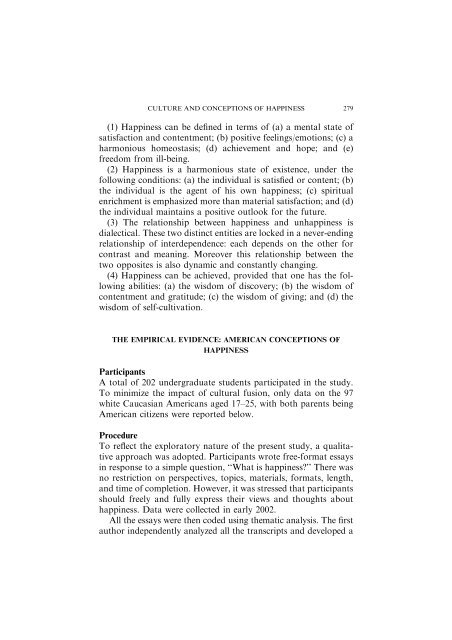CULTURE AND CONCEPTIONS OF HAPPINESS: INDIVIDUAL ...
CULTURE AND CONCEPTIONS OF HAPPINESS: INDIVIDUAL ...
CULTURE AND CONCEPTIONS OF HAPPINESS: INDIVIDUAL ...
Create successful ePaper yourself
Turn your PDF publications into a flip-book with our unique Google optimized e-Paper software.
<strong>CULTURE</strong> <strong>AND</strong> <strong>CONCEPTIONS</strong> <strong>OF</strong> <strong>HAPPINESS</strong> 279(1) Happiness can be defined in terms of (a) a mental state ofsatisfaction and contentment; (b) positive feelings/emotions; (c) aharmonious homeostasis; (d) achievement and hope; and (e)freedom from ill-being.(2) Happiness is a harmonious state of existence, under thefollowing conditions: (a) the individual is satisfied or content; (b)the individual is the agent of his own happiness; (c) spiritualenrichment is emphasized more than material satisfaction; and (d)the individual maintains a positive outlook for the future.(3) The relationship between happiness and unhappiness isdialectical. These two distinct entities are locked in a never-endingrelationship of interdependence: each depends on the other forcontrast and meaning. Moreover this relationship between thetwo opposites is also dynamic and constantly changing.(4) Happiness can be achieved, provided that one has the followingabilities: (a) the wisdom of discovery; (b) the wisdom ofcontentment and gratitude; (c) the wisdom of giving; and (d) thewisdom of self-cultivation.THE EMPIRICAL EVIDENCE: AMERICAN <strong>CONCEPTIONS</strong> <strong>OF</strong><strong>HAPPINESS</strong>ParticipantsA total of 202 undergraduate students participated in the study.To minimize the impact of cultural fusion, only data on the 97white Caucasian Americans aged 17–25, with both parents beingAmerican citizens were reported below.ProcedureTo reflect the exploratory nature of the present study, a qualitativeapproach was adopted. Participants wrote free-format essaysin response to a simple question, ‘‘What is happiness?’’ There wasno restriction on perspectives, topics, materials, formats, length,and time of completion. However, it was stressed that participantsshould freely and fully express their views and thoughts abouthappiness. Data were collected in early 2002.All the essays were then coded using thematic analysis. The firstauthor independently analyzed all the transcripts and developed a

















